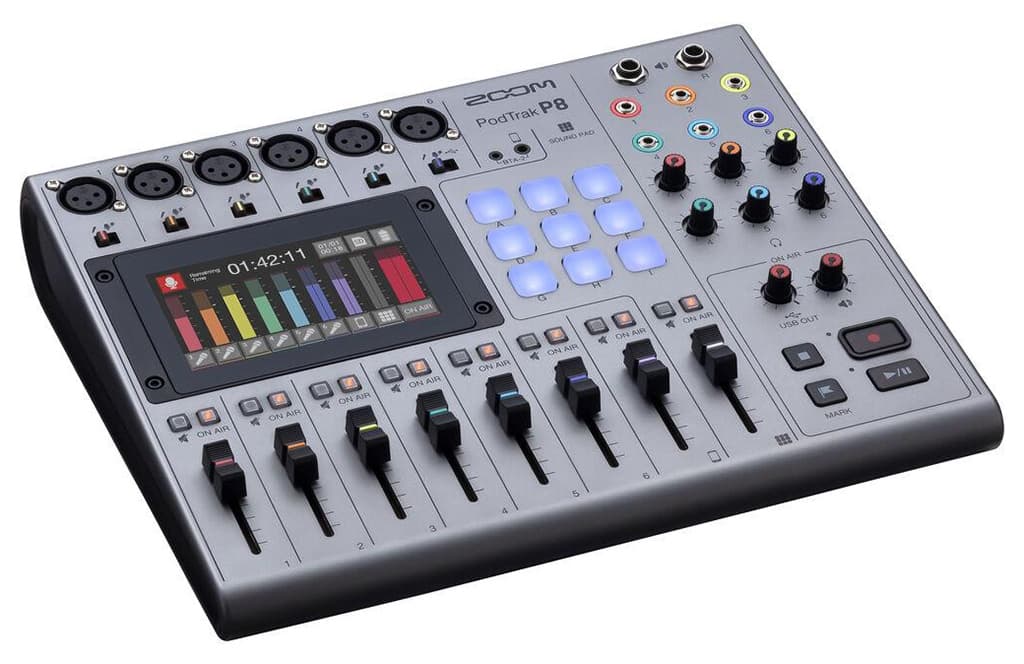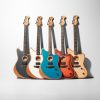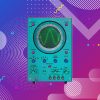
Review: Zoom Podtrak
Zoom draws on its expertise in creating all-in-one mixers to create a machine aimed squarely at non-tech savvy podcasters.
I don’t imagine podcasters often find themselves craving a 2dB cut at 450Hz or a smoother knee bend on a tube-modelled compressor. Neither do they revel in consoles with more knobs and buttons than Joe Rogan’s subscriber base. No, a solid vocal tone and a few understandable cherry-picked controls are more than sufficient to get a podcaster happily on air.
Zoom knows this, and answered the call with its PodTrak P8 – an all-in-one podcast production machine which assumes its users only care about one thing: podcasting.
The PodTrak P8 is a petite and lightweight unit with a design that’s more playful than rugged. While a studio engineer may turn their nose up at the aesthetic, I’m convinced PodTrak P8 is a perfect confidence booster for the majority of podcast producers who are big on ideas and just want to get on with it. Colours are everywhere – the switch beneath each XLR input is colour coded to the corresponding channel fader, which matches the channel number’s headphone output and level knob, as well as the meter colour on the screen. Losing your bearings is all but impossible on the PodTrak P8.
That said, let’s not forget Zoom knows a thing or two about building high quality portable recorders. All the faders, buttons and knobs on the P8 are reassuringly firm and responsive. Battery powered operation off four AA batteries is a big selling point on the P8 – it’s the only product of its type which offers this out of the box. The touchscreen is nice to work with although I could’ve gone a resolution that isn’t so Minecraft. Set the brightness via the top right power plug icon. Different battery types and Tablet Mode are also set in this menu.
Besides the six 3.5mm headphone outputs PodTrak has a pair of balanced 6.5mm TRS outs for monitoring on speakers. The USB-C connector bridges the PodTrak P8 and your computer for file transfer or 2×2 audio interfacing, and can also accept power from a USB power bank.
A podcast can be recorded onto an SD card in three ways – stereo mixdown only, multi-tracked without processing, or multi-tracked with processing. Unfortunately multi-track recording via USB isn’t possible.
GROUP DYNAMICS
Throwing six XLR inputs into the PodTrak P8 sets it apart from competing products and ensures no guest is turned away. Mics aren’t discriminated against either, with a walloping 70dB of clean gain – pull out the SM7B and leave the Cloudlifter in the cupboard! And to make sure your favourite condensers don’t miss the party, phantom power is individually switchable per channel. Additionally the PodTrak accepts a TRRS 3.5mm input labelled Phone, which doubles as a Bluetooth input if you purchase the optional BTA-2 adapter from Zoom. A trick up channel 6’s sleeve is it can be switched to USB input which takes audio from a connected computer. Both USB and Phone I/O can supply a mix-minus send back down the line for use in phone or video calls. Finally you have the audio from the nine sound pads which shows up as the final fader.
Sounds pads are, of course, one of the markers that distinguish a podcasting recorder from any other hardware recorder. Each contains a pre-loaded soundbite of some sort, and you can swap them out for bespoke intros and outros for your show, advertisements, applause, jingles, ‘badum-tsh’ samples, and little stingers to transition between segments.
PodTrak P8 implements the concept in a very functional manner. Although you see only nine pads, there are in fact four banks, which gives you a capacity of 36 sounds. If you host multiple shows you can have a bank for each (banks are re-nameable), or maybe you get a kick out of using 36 sounds in a single episode. Whatever the case, it’s a generous amount of pre-loadable potential. Press the icon below the soundpad channel to view what’s loaded on each pad. Click on a sample to adjust its volume and play mode (One Shot, Pause, Loop or Hold). Because play mode is adjustable per pad, there are a huge number of ways to configure them. For example, you can load a background music loop onto pad A and keep it looping throughout your show, but load One Shot samples onto pads B, C and D. Multiple pads can play at the same time.
The PodTrak P8’s Noise Reduction is more of an automixer than a simple gate, sensing which mics aren’t being spoken into and turning them down. It’s a tool that becomes increasingly invaluable the more open mics you have in a recording.
NEED TO KNOW
ZOOM PODTRAK
Podcast Recorder

NEED TO KNOW BASIS
Press the icon underneath a channel’s meter on the touchscreen to open its input processing options. Above the gain slider is a meter with assists for dialling in an ideal input level – Low, Good and Over. You can engage a limiter and low cut filter here as well.
Zoom has understandably simplified EQ to a single slider which swings between ‘Bass’ and ‘Treble’. In use it quite clearly attenuates and boosts at either extreme, like a seesaw pivoting at 1k. Of course I would prefer a parametric EQ with sweepable mids but, again, Zoom deemed a single-control approach perfectly sufficient for its target market. The same uncomplicated philosophy applies to the Compressor/DeEsser where the Min/Max slider is labelled ‘Make your voice sound professional.’ Not gonna lie – it seems odd having the compressor directly linked to the de-esser. I assume the rationale is to negate sibilance as compression pronounces it but it’d be nice to have the option for one or the other when input sources aren’t quite so predictable. The Phone channel offers a two-band EQ with separate sliders for Bass and Treble. Despite my complaints, I have to admit the foolproof controls work fine the majority of the time.
SHOWING UP
Your podcast guests are in, mics are setup, Skype call running, headphones donned. Now what?
First, make sure a fresh SD card is inserted and formatted.
Then, you’ll need to decide who’s going to be recorded. If one or more guests will enter the show later, or are just there to listen in, un-click the ‘On Air’ button on their microphone channel. You’ll still hear them and they’ll hear you, but their mic output won’t be recorded to the SD card or play through the speakers/USB output. If you want to shut them up altogether, press Mute.
Then press the big red button. The Mark button will drop markers into the file at different points in the recording. Using the super responsive sound pads mid-show is fun and seamless, as is live mixing on the smooth faders. Be aware of the loud click made by the On Air and Mute buttons; silent rubber buttons would’ve been preferable here. Recordings can be paused and resumed with the Play/Pause button whereas Stop will finalise the recorded file and place it in the library.
POST PRODUCTION
PodTrak P8 shows its true colours after recording. Uniquely, the little mixer offers a measure of onboard audio editing capability. I was expecting no more than a top and tail cut function but was pleasantly surprised by how much useful editing can be done on that little screen.
Pulling up a recorded file displays its full waveform along the bottom of the screen. With the row of tools above it you can easily trim start and edit points, place a cut point anywhere to split into multiple files, drop in a background music bed from a file on the SD card, optimise overall level with an automatic function, and even place fade ins and fade outs. Play and pause the recording with the physical button or on-screen, and use the Mark button to drop markers for referencing edit points. When you’re finished, export it as an MP3 file. Enter Transfer mode to copy it to your computer via USB.
I flew through a quick cleanup and edit of a recording much quicker than expected. The only thing I missed was a scrub/jog wheel but you can’t have everything. In fact, I’d suggest Zoom has sufficiently tooled up the PodTrak P8’s edit functionality to allow most seasoned podcasters to only need a computer to upload the episode, unless some surgical or single track-level editing is required.
The Zoom PodTrak P8 is for podcasters. Everything about it caters to the immediate demands of managing, recording and editing a podcast without being so technical it obstructs organic conversation or creative flow. For aspiring or experienced podcasters alike, the PodTrak P8 deserves a serious look.























RESPONSES